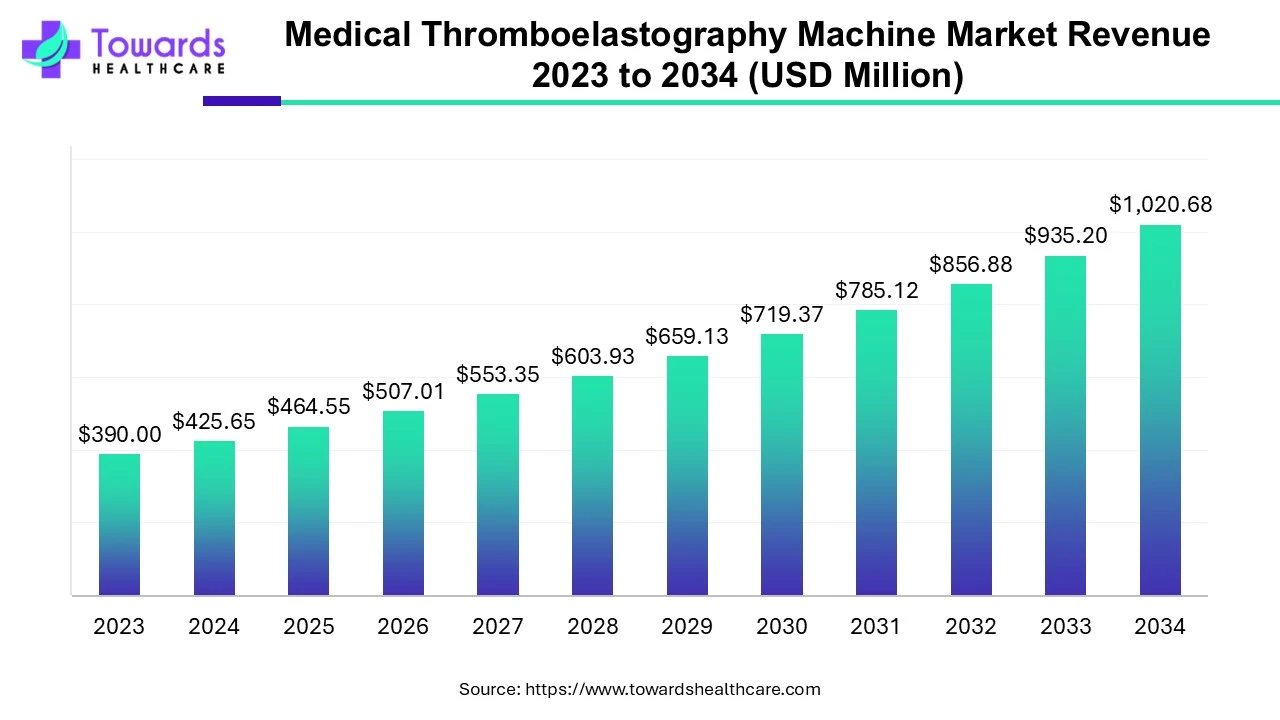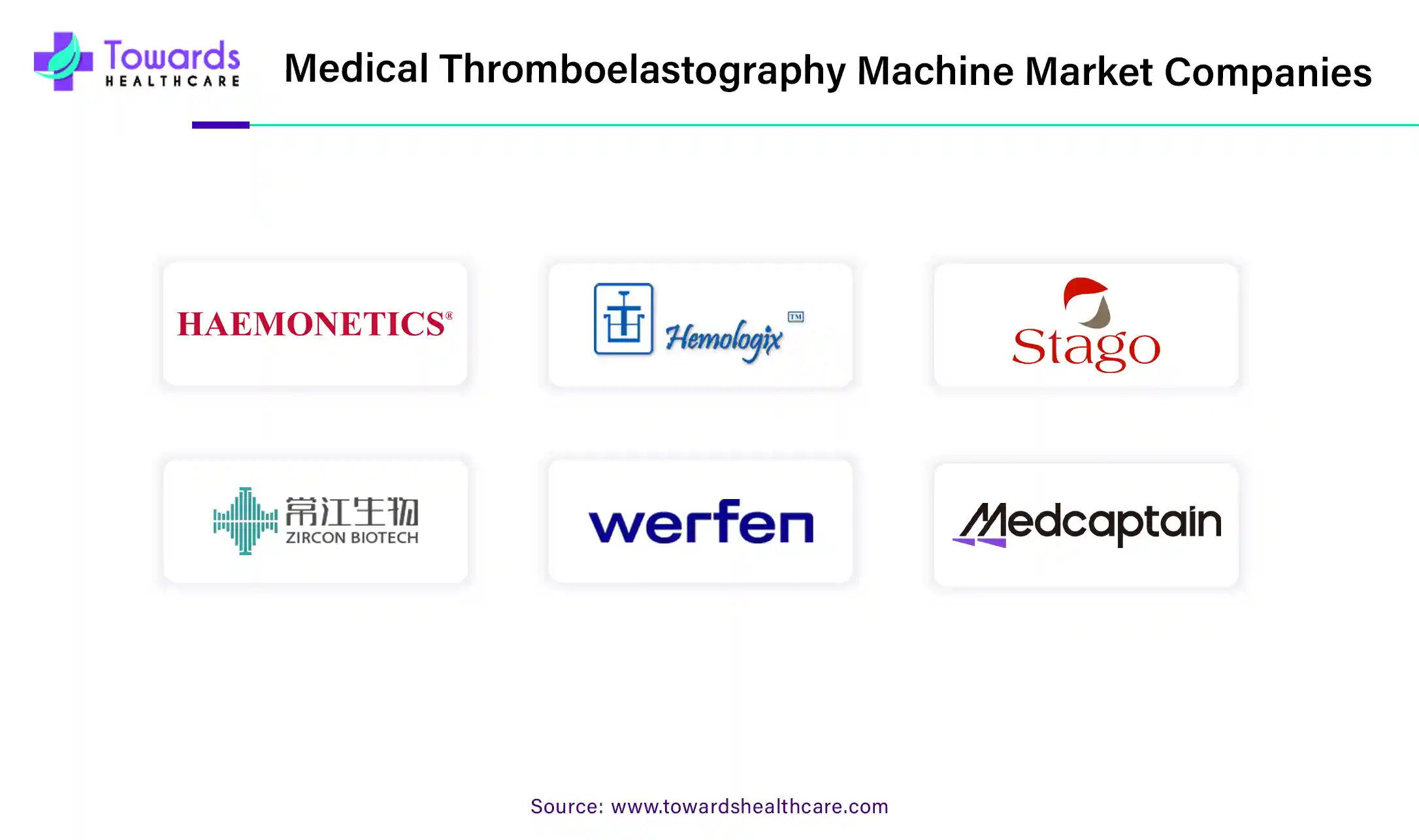April 2025

The global medical thromboelastography machine market was evaluated at US$ 390 million in 2023 and is expected to attain around US$ 1020.68 million by 2034, growing at a CAGR of 9.14% from 2024 to 2034. The medical thromboelastography machine market is growing as thromboelastometry helps diagnose, manage, and monitor hemostasis and also improves certain clinical outcomes in cardiac surgery patients.

The medical thromboelastography machine market is growing rapidly because TEG is especially useful in major surgeries, such as heart surgery, where blood loss is a concern. It can also be used in emergencies to control bleeding after injury or hemorrhage and can be used to monitor coagulation during cardiopulmonary resuscitation, anticoagulation management in patients with total heart failure, extracorporeal membrane oxygenation, and predictive bleeding during invasive procedures in patients with cirrhosis and coagulopathy, to identify susceptible patients after central venous cannulation in patients with cirrhosis and to patients who can undergo minor surgery without the risk of bleeding despite strong PT.
Thromboelastography (TEG) is a diagnostic test with many advantages over other tests. As evidence of its therapeutic efficacy increases, TEG has become a more widely used test. TEG can detect coagulation disorders in patients with intracranial hemorrhage and hematoma expansion. TEG can also be used in the treatment of liver disease, blood loss, severe liver disease, hypertension, and hemorrhagic disease.
The development of the rapid diagnostic test (r-TEG) represents a significant advance in diagnosis and improves hemostatic control in the clinic. R-TEG uses tissues to replace the traditional kaolin-cephalin reagent to activate blood coagulation and speed up the diagnostic process by participating in the extrinsic coagulation process.
This innovation, which can be tested in 15 minutes, is particularly useful in monitoring blood pressure in trauma patients. In addition, the application of thromboelastometry in cardiac surgery is improving the detection, management, and monitoring of hemostatic conditions, thereby increasing the demand for the medical thromboelastography machine market. The development of diagnostic tools should contribute to economic growth by improving patient outcomes and hospital operations.
The integration of automation and AI into thromboelastography testing offers a significant opportunity to increase the efficiency and accuracy of these diseases. It provides an additional, specific assessment of the severity and various coagulation disorders. TEG technology can be used in many clinical areas, focusing on the point of care, and providing immediate analysis of bone formation and fracture. The development of algorithms that incorporate TEG analysis to manage bleeding patients has been shown to have the potential to reduce blood transfusions and improve clinical outcomes, and the medical thromboelastography machine market for substantial growth as healthcare providers adopt these advanced solutions.
The growth of the medical thromboelastography machine market is limited by several important factors. The diagnostic process is not as fast as the empirical method, and valuable time can be consumed in critical situations. Furthermore, the overall cost of thromboelastometry can be higher than traditional coagulation tests when accounting for recalibration and maintenance expenses. It is limited to small areas in the region, further restricting access. Furthermore, routine administration of tranexamic acid, which is cost-effective and safe, often requires assessment of fibrinolysis, and special training is required for the quality of its use and interpretation of results. Also, the technology is inadequate in addressing hypothermia-related coagulopathies, further limiting its medical thromboelastography machine market applicability and growth.
By region North America is dominated in the medical thromboelastography machine market as it is the largest medical market in the world and accounts for more than 40% of the global medical patient technology industry. Medical technology innovators work to provide doctors and other healthcare professionals with the best tools to diagnose and treat patients. This commitment drives more than 6,500 medical technology companies, mostly small and medium-sized enterprises, that produce medical technology every day in the United States.
The medical technology industry is a manufacturing success and one of the fastest-growing industries in the United States, that merges rapid innovation with precision product building and distribution. The industry is a world leader, with homegrown R&D, domestic manufacturing in communities large and small, and worldwide exports of American-made products. The advancements in medical technology throughout North America due to the continuous development that has led to the growth of the medical thromboelastography machine market.
Asia Pacific is expected to witness significant growth in the medical thromboelastography machine market during the forecast period as healthcare providers in the region adopt more advanced technologies, including artificial intelligence and cloud technology in their care models. Increasing healthcare spending in the Asia Pacific region is inevitable. Fast-aging populations, growing middle classes, increasing health awareness, and favorable government initiatives are few factors that promote the growth of the market in Asian area.
By type, single-channel and double-channel segments constitute the medical thromboelastometry machine market as it reduces the risk of sampling and measurement errors. Each chamber has a platform with a disposable cup where the blood sample is collected and a detection pin suspended in its center. The four-channel segment is the fastest growing and it allows experiments with different activators, platelet blockade, and aprotinin or heparinase in addition to four channels at the simultaneous testing time.
In terms of application, the hospital segment dominates the medical thromboelastography machine market as it is used to evaluate the hemostatic properties of blood, identify coagulopathies, and guide the management of blood products. Whereas the clinic's segment is fastest growing as the need for organ transplantation and blood loss in heart surgeries, heart transplants, and major trauma.

By Type
By Application
By Geography
April 2025
April 2025
April 2025
April 2025